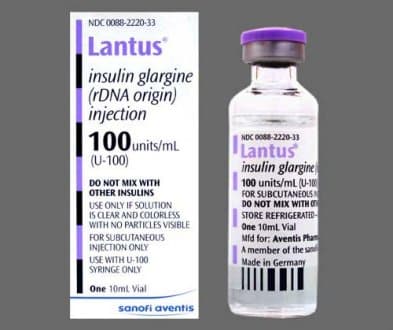What is Lantus insulin?
Lantus is a long-acting injection that contains insulin glargine as its active ingredient. Designed to be injected subcutaneously, insulin glargine is a recombinant analogue of human insulin that has hypoglycemic properties. Derived from the non-pathogenic strain of Escherichia coli, insulin glargine lacks amino acid asparagine at position A21. Instead, it contains glycine at A21 and arginine at both the C-terminus of the B-chain. Although this may seem confusing, it simply means that this insulin works for longer periods of time in order to keep your blood sugar levels under control.
How does Lantus insulin work in the body?
How Does Lantus Insulin Work? Indicated for adult patients with type I and type II diabetes and pediatrics with type I diabetes, Lantus effectively lowers the elevated blood sugar levels for better glycemic control. It exerts its blood sugar-lowering actions through glucose metabolism. This medication inhibits the synthesis of glucose in the liver while promoting glucose uptake peripherally (particularly by fat and skeletal muscle). It is believed that Lantus prevents proteolysis and lipolysis, thereby enhancing protein synthesis. The injection also promotes DNA replication through muscle and hepatic uptake of amino acids. Plus, this insulin drug helps stimulate glycogenesis to promote energy storage while opposing catabolism.
Essential for growth, insulin glargine is involved in the modulation of growth hormones and plays a role in cell division. Being completely soluble at acidic pH (pH 4), Lantus is virtually insoluble at a neutral pH. Once administrated, the solution undergoes neutralization and loses its acidity. Consequently, microprecipitates (from which insulin glargine is gradually released in small amount) are formed. This contributes to a steady concentration/time profile without any pronounced peak, which allows for the once-per-day dosing. At the same time, there is a lower risk of nocturnal hypoglycemia. Thanks to its predictable action profile, the drug is able to mimic the basal levels of insulin, helping to maintain glycemic control all day long.
Doctor’s Recommendation
Talk openly with your doctor about any concerns you have about Lantus and your treatment plan. Before your appointment, write down questions about how Lantus might affect your body, emotions, or daily life. Bringing a friend or family member for support can help you feel more at ease. If there’s anything about your condition or treatment that you don’t understand, ask your doctor to explain it. Your healthcare team is here to help, so don’t hesitate to ask questions and share your thoughts to make sure your treatment plan works best for you.
—
Disclaimer: Please note that the contents of this community article are strictly for informational purposes and should not be considered as medical advice. This article, and other community articles, are not written or reviewed for medical validity by Canadian Insulin or its staff. All views and opinions expressed by the contributing authors are not endorsed by Canadian Insulin. Always consult a medical professional for medical advice, diagnosis, and treatment.



